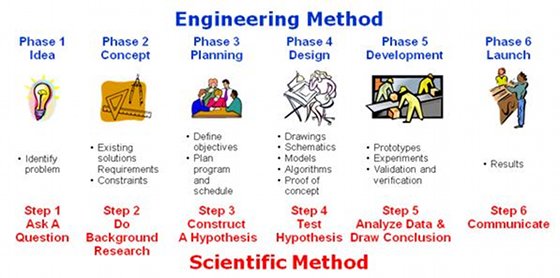Engineering Method
Abstract
The engineering method (also known as engineering design) is a systematic approach used to reach the desired solution to a problem. There are six steps (or phases): idea, concept, planning, design, development, and launch from problem definition to desired result.
Overview
The engineering method (design) is a systematic approach used to support an engineer or project team in reaching the desired solution to a problem, which has been specified by customers, sponsors, or stakeholders who perceive value in resolving the problem.

Figure 1
Engineering Method. Source: Ronald L. Lasser
The engineering method has six steps (or phases):
- Idea
- Concept
- Planning
- Design
- Development
- Launch
The development step is often divided to include the iterative cycle of build, test, debug, and redesign. The engineering method by nature is an iterative process.
1. Idea
The idea phase usually begins with a problem. The problem statement is typically only vaguely defined and requires research into its viability and its feasibility. Viability suggests that there is significant value (or demand in the case of product development) in pursing the solution. Feasibility serves as a check on whether the idea can be realized. Feasibility may be high, medium, or low: where high feasibility means that people, technology, and time resources are readily available or known; medium is that resources may not be available directly, but can be found; and low means the resources may be rare or do not exist. The most critical part of the idea phase is to define the problem, validate its value, and identify the customer who desires its solution.
2. Concept
The concept phase is about generating numerous models (mathematical, physical, simulation, simple drawings or sketches), all of which should convey that the solution meets the customer’s expectations or requirements. The numerous concepts are generated using brainstorming techniques, which are review sessions in which elements of one concept are recombined with elements from other in an effort to find a single concept that fits best. Typical design judgment and compromise are required to merge concepts. The concept phase ends with a selection of a single concept.
3. Planning
The planning phase is about defining the implementation plan: identifying the people, tasks, task durations, task dependencies, task interconnections, and budget required to get the project done. Many tools are used to convey this information to team members and other stakeholders including Gantt and Pert charts, resource loading spreadsheets, sketches, drawings, proof-of-concept models to validate that the project can be successfully completed.
One critical tool of the planning phase is the system engineering diagram. This diagram shows the solution as an interconnection of smaller and less complicated sub-systems. A system engineering diagram establishes all the inputs and outputs for each module, as well as the way in which the module transforms the inputs into outputs.
4. Design
The design phase is where “the rubber meets the road.” Details are specified; specifications are established. Some call this phase “design planning” and the development phase “detailed design.” But no matter what it is called, the purpose of this phase is to translate the customer requirements and systems engineering model into engineering specifications that an engineer (designer) can work with to design and build a working prototype. Specifications are detailed using a number with associated units, e.g., 4 volts, or 3.82 inches, or 58 Hz, or a completion time of 22 days.
5. Development
The purpose of development is to generate the engineering documentation: schematics, drawings, source code, and other design information into a working prototype that demonstrates the solution to the problem. The solution may be a tangible working prototype or an intangible working simulation. Of course, nothing works the first time, so this part of the process tends to be more iterative than the other phases. Specifically, it consists of the iterative cycle: design, test, debug, and redesign. If the project had earlier delays or is not on the planned schedule for other reasons, then this time may be the most frantic since the customer deadline may be closely looming.
While testing and debug are often consider a separate phase, most times they occur side-by-side with development as a design morphs from a concept to an artifact. The latter is recommended, reserving time at the end of development for a final test to confirm the desired result meets customer expectation and designer’s intent. Testing is the verification and validation phase where the concept meets both the anticipated design specifications and the customer’s requirements of the solution. Testing is achieved through experiments—an information-gathering method where dissimilarity and difference are assessed with respect to the design’s present and compared to desired state for the design. The purpose of an experiment is to determine whether test results agree or conflict with the a priori stated behavior. A sufficient numbers of successful testing verifications and validations are necessary to generate acceptable results and to reduce any risk that the desired behavior is present and functions as expected. If the test observations and results do not agree, then a debug process is necessary to identify the root causes and begin corrective action to resolve the discrepancies.
6. Launch
Launch includes the release of the engineering design and documentation package to manufacturing facilities for production. At this point, all qualification testing is complete, and the working prototype has demonstrated functionality.
Cited References
- Ertas, A., & Jones, J. C. (1996). The Engineering design process (2nd ed.). New York: John Wiley & Sons. OCLC WorldCat Permalink: http://www.worldcat.org/oclc/807148675
- Ullman, D. G. (2009). The Mechanical Design Process (4th ed.). New York, N.Y.: McGraw Hill. OCLC WorldCat Permalink: http://www.worldcat.org/oclc/244060468
- Ulrich, K.T., & Eppinger, S. D. (2008). Product Design and Development (4th ed.) New York, N.Y.: McGraw Hill. OCLC WorldCat Permalink: http://www.worldcat.org/oclc/122424997

